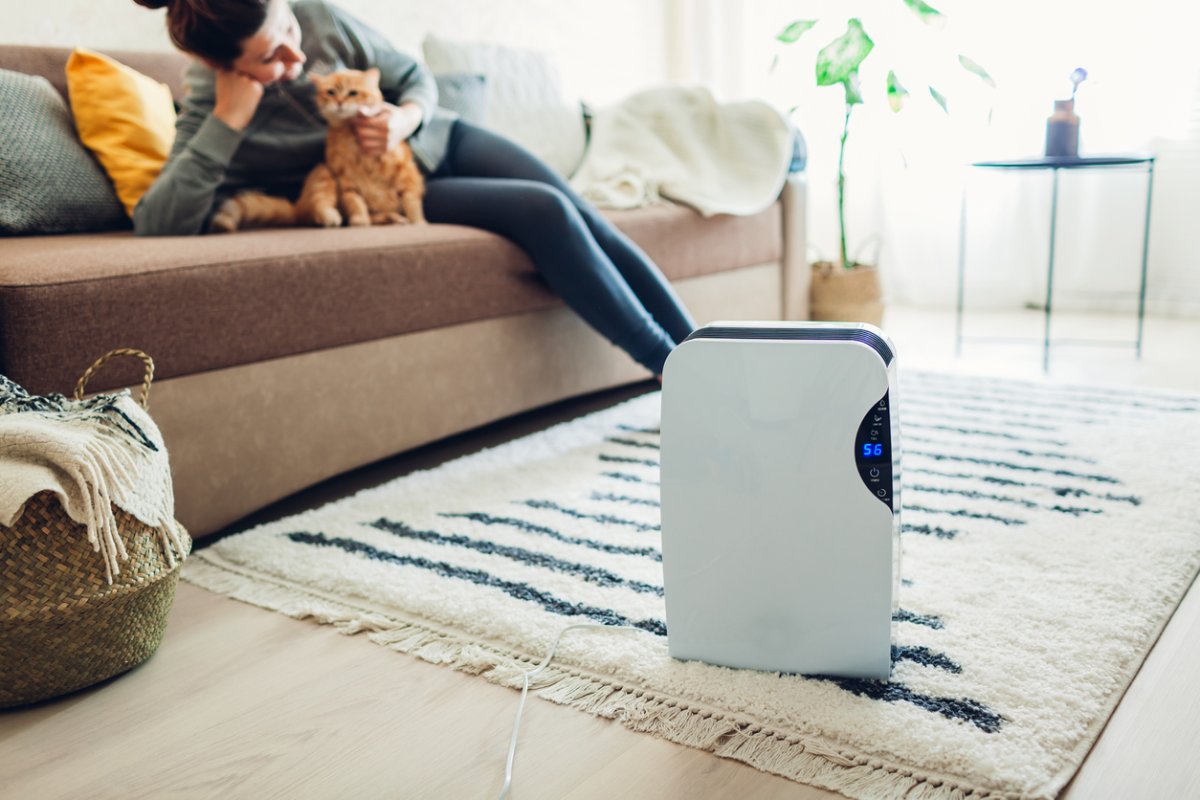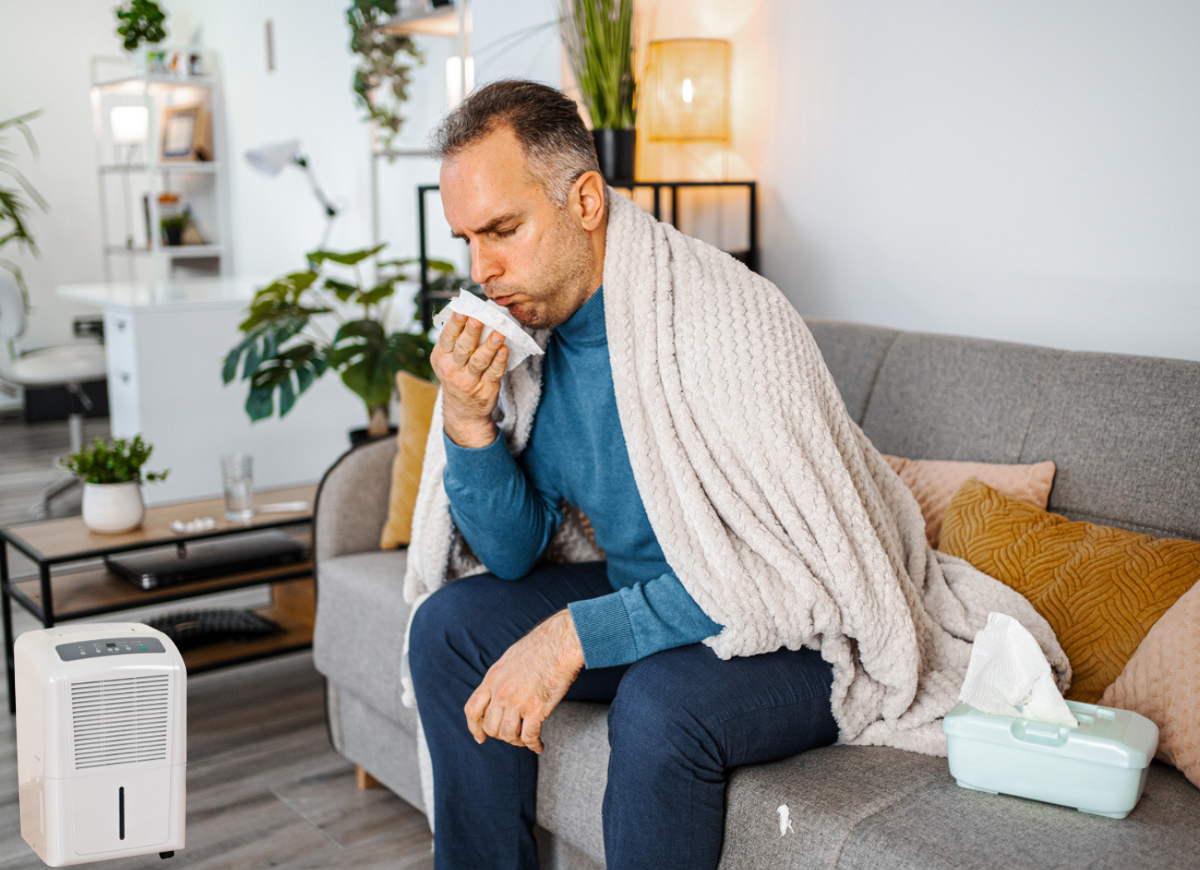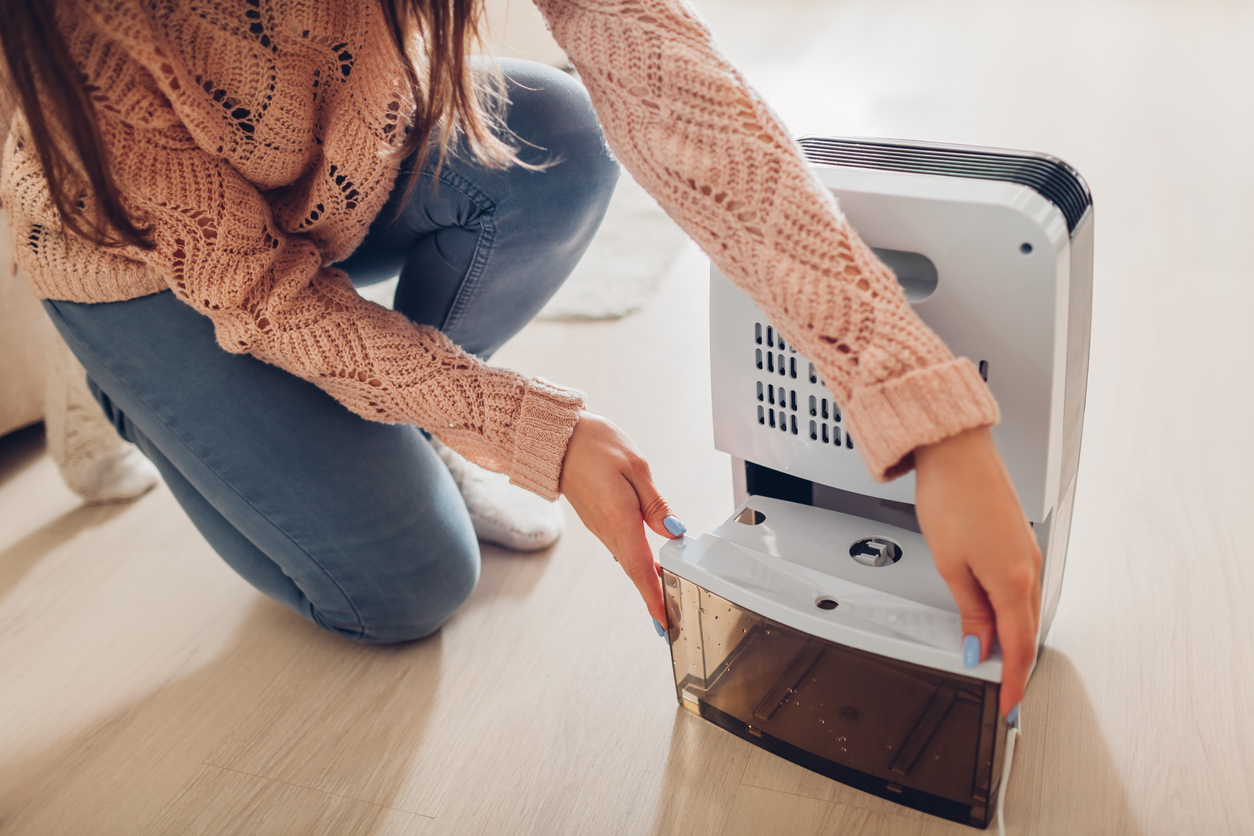

We may earn revenue from the products available on this page and participate in affiliate programs. Learn More ›
Air quality can suffer in myriad ways. Excess humidity ranks among the least desirable effects. Left unchecked, moisture buildup can lead to several problems within the home including, but not limited to, musty odors, warped wood, peeling paint, and mold.
If at any point during the year, you become concerned about the high humidity level inside, what can you do to alter the status quo? One word: dehumidifier. We consulted Josh Mitchell, HVAC technician and owner of Air Conditioner Lab, and Dan Mingle, Vice President of Denver-based Sanders & Johnson Heating & Cooling, for their expert insights on how to choose a dehumidifier for your home.
What’s the purpose of a dehumidifier?

Dehumidifiers help reduce excess moisture and water damage within the home, which makes it easier to breathe. “This excessive moisture often results from regional climate, poor ventilation, daily activities like cooking and showering, or even structural issues such as damp basements,” Mitchell says.
Dehumidifying also helps stop mold, mildew, and even dust mites from spreading throughout the home. This is an important preventive measure, given that mold is drawn to many common building materials, like ceiling tiles, wood, and wood products.
According to the CDC, exposure to damp, moldy environments can cause a variety of health problems that range from mild symptoms, like a stuffy nose or wheezing, to more serious symptoms such as fever, shortness of breath, and the development of asthma in children.
“One of the most striking transformations I witnessed was with a family constantly battling mold in their basement,” Mitchell explains. “Their son had allergies, which were intensified by the spores. After installing a dehumidifier, the mold issue drastically receded, and the family reported a significant improvement in their son’s health and a fresher smell in their home. It was a clear case where controlling humidity directly bolstered well-being.”
How does a dehumidifier work?
Dehumidifiers range in size from portable, one-room units to whole-house solutions that tie into the home’s HVAC system. Though variations exist both in product design and quality, most dehumidifiers work the same way. You configure the preferred humidity level, and when the humidistat registers a level that exceeds your preference, the dehumidifier clicks on.
Driven by a fan, moist air moves through the appliance, where it passes over a cold metal coil. At that point, the moisture condenses into water, which the unit stores internally or drains away. The filtered air then passes over a warm coil before returning to the home’s conditioned space. The owner just needs to regularly empty any collected water.
“Today’s market offers dehumidifiers with fascinating upgrades like built-in hygrometers, auto shut-off, and continuous drainage options, making them more user-friendly than ever. I’d say, look for models with Energy Star ratings for efficiency,” Mitchell says. “Features like digital humidity readouts, user-friendly controls, and perhaps even WiFi connectivity for smart homes can be worth the extra investment, depending on your needs.”
Does my home need a dehumidifier?
Before jumping to buy the first dehumidifier that you find, you should first figure out if you really need one. Taking these steps will help you determine if your home is too humid, and help you choose the right dehumidifier for your space.
First, test your home for excess moisture.
There are several signs of high humidity in a home that can help you determine that you need a dehumidifier. Inspect the windows and doors for fogging or excess condensation and note whether any moisture is accumulating on the walls or ceilings.
If you see some of these signs but aren’t certain whether your home has been experiencing significant moisture issues, research the problem by purchasing and monitoring a humidity gauge, also known as a hygrometer. This device monitors the indoor air quality and reports the readings.
For most homes, a humidity level of between 30 and 60 percent shouldn’t cause issues, but narrowing the range to the ideal indoor humidity level of about 30 to 50 percent will help ensure that the air is easy to breathe and the home is comfortable. Humidity levels higher than this ideal range should be treated with a dehumidifier.
“Running a dehumidifier can indeed influence radon levels, a common issue in homes built on soil rich in uranium, thorium, and radium. By keeping basements dry, dehumidifiers help limit the soil dampness that contributes to radon’s rise through the foundations. Additionally, a less humid environment is generally less hospitable to many pests, like cockroaches and other insects.”
—Josh Mitchell, HVAC technician and owner of Air Conditioner Lab<
Next, determine how widespread your humidity problem is.
Is your entire house overly humid, or is the issue confined to one area, such as the basement? The scope of the problem directly determines the nature of the solution. Larger whole-home dehumidifiers tie into the HVAC system and include a drainpipe that empties directly into a slop sink, sump pump, or to the outdoors. These types of dehumidifiers aren’t cheap and typically involve professional installation.
“Large or multi-story homes can benefit from whole-house dehumidifiers since they can effectively manage humidity levels on all floors and in all rooms, providing comfort throughout the house,” Mingle says.
Portable dehumidifiers, meanwhile, are are much less expensive and more consumer-friendly way to lower humidity in your home. They plug into the wall and operate via built-in interfaces that are easy to understand and configure. Some portable dehumidifiers are equipped with hoses that can drain or pump out collected water automatically; others have a collection bucket that must be emptied on a regular basis.
What size dehumidifier do I need?
Even dehumidifiers of the same basic design can differ in capacity. For a 500-square-foot space, select a dehumidifier that can hold 10 pints of water; add 4 pints of capacity for every additional 500 square feet. To determine the size of humidifier for a 1,000-square-foot basement, you’d need to add 4 pints for a total 14-pint capacity.
If you’re shopping for a basement humidifier to place in a particularly dank lower level (or for a crawl space dehumidifier), you may want to consider getting a larger-capacity unit than you might otherwise, so it can efficiently remove the higher level of moisture from the air in that space. Choose a dehumidifier that holds 12 pints of water for a 500-square-foot space, adding 5 pints for every additional 500 square feet.
When searching for the best dehumidifier for your space, Mingle suggests considering these factors:
“First, the pint capacity of a dehumidifier is crucial, as it dictates the amount of moisture it can remove from the air in a 24-hour period, making it important to choose a capacity that matches the size of your space and its moisture levels. The tank size is equally important, as it stores the collected moisture,” Mingle continues. “Dehumidifiers with larger tanks or auto shut-off functions when the tank is full are advisable, especially in high-humidity areas. To maintain ideal humidity levels, having a humidistat, either built-in or separate, is beneficial.”

What to Consider When Purchasing a Dehumidifier
1. Home size
The square footage of the home or of the room where you will set up the dehumidifier is the main deciding factor for choosing a product, but there are other household conditions that can affect the humidity level in the home and what size humidifier you need.
2. Number of home occupants
People consume water, sweat, and breathe out hot, humid air, which is why the more people live in the home, the higher the humidity will be. In most homes, the humidity produced by humans is relatively unimportant, but large families of six or more people might want to consider a larger dehumidifier to handle increased humidity levels.
3. Number of doors and windows in home
The size and number of doors and windows in the home can also influence the humidity levels indoors. Windows and doors allow heat to transfer more easily into the home, so the more windows and doors, the higher the humidity. Similarly, very large windows are poor insulators, leading to higher levels of humidity.
4. Number and location of bathrooms and laundry facilities
Laundry rooms and bathrooms can affect a home’s humidity level when you use the washing machine or shower, so it’s important to invest in a dehumidifier that can handle the increased moisture in the air.
5. Energy efficiency
Energy Star-rated dehumidifiers use about 15 percent less energy than conventional units. In the long run, that means a savings of approximately $175 over the life of a dehumidifier, not to mention avoiding roughly 2,800 pounds’ worth of greenhouse gas emissions.
Dehumidifiers can provide a continuous flow of fresh, dry air in the home, resulting in an energy-efficient solution that improves indoor air quality and keeps mold growth at bay all season long.
“In my own home, I use a Frigidaire dehumidifier. It’s energy-efficient, operates quietly, and maintains humidity levels impeccably, which is particularly useful during our humid summers,” Mitchell says.
Pros and Cons of Using Dehumidifiers
Pros
- The units can reduce allergy symptoms and other health issues by stopping the spread of mold, mildew, and dust mites in the home.
- These devices help to reduce the ambient moisture in the air, protecting the home from rust and decay that can occur when walls, ceilings, and windows accumulate moisture.
Cons
- A higher monthly electricity bill.
- They require regular maintenance to ensure that they continue to function correctly. Maintenance includes emptying the collection bucket, cleaning the unit, and replacing the air filter to purify the air.
- The ongoing hum of the dehumidifier, especially on higher operating levels, can also be a nuisance to some people, so it’s important to research how loud a dehumidifier is—and whether you actually need one—before bringing one home.
FAQs
Most dehumidifiers have a built-in humidistat to measure the ambient humidity, so while an oversize dehumidifier can cause the air in the home to dry out quickly, it should shut off when the humidity levels reach the preferred setting.
However, without this automatic measurement and control, a dehumidifier can be too large for the space. It can dry out the air rapidly to the point where it is too dry and you might need a humidifier to help reverse the effects.
A whole-house dehumidifier is intended for this very purpose. These products can have a range that exceeds 5,000 square feet, allowing them to condition the air throughout the home.
No, do not leave the dehumidifier on all the time. Not only is it unnecessary, but excessively dry air can lead to breathing problems, like bronchitis, sinusitis, asthma, and nosebleeds.
The frequency with which you empty the dehumidifier depends on how often the device runs. Typically, a dehumidifier should be emptied twice a day, but some homes might only need to empty the bucket once every 2 days or so. Just be diligent about checking the dehumidifier when it is first set up to get a better understanding of how long it takes for the dehumidifier bucket to fill up.
